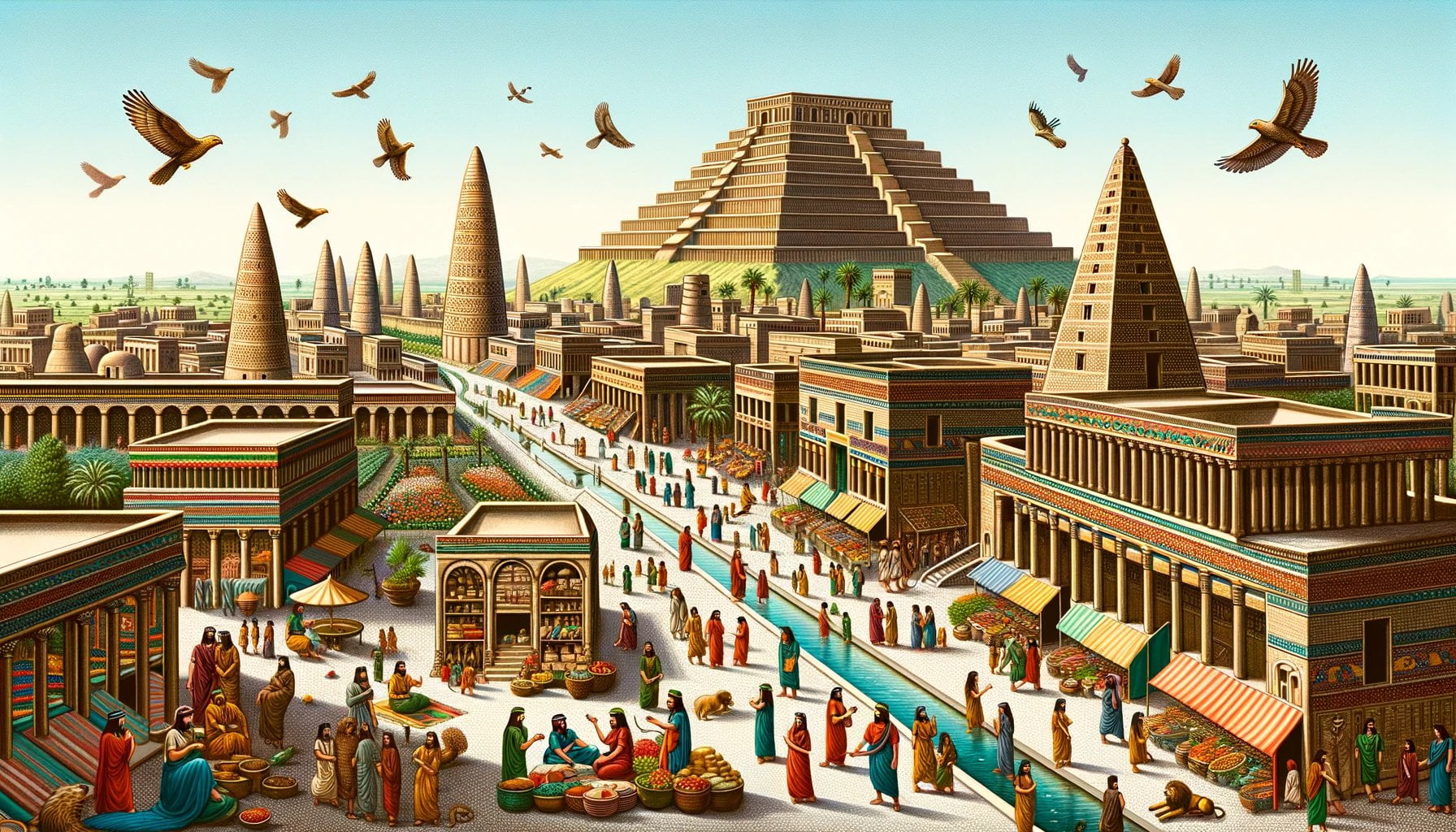Discover Mesopotamia’s remarkable achievements in invention, agriculture, writing, governance, and art as we delve into the fascinating world of this ancient civilization. With a keen focus on uncovering and understanding the rich accomplishments of Mesopotamia, we aim to provide readers with a concise and comprehensive account of the remarkable advancements that revolutionized the world during this period. From groundbreaking inventions to the development of complex agricultural techniques, from the invention of writing systems to the establishment of sophisticated governance structures, and from stunning artistic creations to architectural marvels, the achievements of Mesopotamia continue to astonish and inspire us to this day.

Key Takeaways:
- Mesopotamia was responsible for many significant achievements in ancient history.
- They built the first cities in the world.
- They invented one of the earliest forms of writing.
- The people of Mesopotamia enacted the first comprehensive legal code.
- They invented the wheel and the chariot.
- They were the first to produce ceramics and bricks on a mass scale.
- Mesopotamians made advancements in mathematics.
- They constructed ziggurats, which were monumental religious structures.
- Mesopotamia introduced legal systems like the Code of Hammurabi.
- The people of Mesopotamia developed advanced irrigation systems.
- They were innovative in architecture.
- Mesopotamians had a significant impact on the field of astrology and astronomy.
For more detailed information, please refer to the following sources:
- Learnodo Newtonic. “10 Major Achievements of the Mesopotamian Civilization.” Learnodo Newtonic. Accessed [date]. [Link]
- World History Encyclopedia. “Mesopotamian Inventions.” World History Encyclopedia. Accessed [date]. [Link]
What Are Some Mesopotamian Achievements?
When we delve into the remarkable history of Mesopotamia, we uncover a vast array of astonishing achievements that have left an indelible mark on civilization as we know it. From groundbreaking inventions to revolutionary advancements in governance and art, the people of Mesopotamia were pioneers in shaping our world. Let’s explore some of their incredible achievements.
Mesopotamian Inventions: Pushing the Boundaries of Innovation
One cannot discuss Mesopotamian achievements without acknowledging their remarkable inventions. Mesopotamia was the birthplace of some of humanity’s earliest breakthroughs. The people of this ancient civilization built the first cities in the world, laying the foundation for urban life as we know it. They also introduced remarkable innovations such as the wheel and chariot, forever revolutionizing transportation and warfare.
But their ingenuity didn’t stop there. Mesopotamians also invented one of the earliest forms of writing, known as cuneiform, which allowed for the recording and dissemination of knowledge. This pivotal development paved the way for the preservation of history and the growth of human understanding.
Advancements in Agriculture: Nurturing Civilization’s Growth
Agriculture played a crucial role in the prosperity of the Mesopotamian civilization. They developed advanced irrigation systems, harnessing the power of rivers such as the Tigris and Euphrates to create intricate networks of canals. This mastery of irrigation allowed them to transform arid lands into fertile agricultural fields, ensuring a steady food supply for their society.
Mesopotamians also excelled in the cultivation of various crops such as wheat, barley, and vegetables, which contributed to their burgeoning civilization. Their advancements in agriculture not only sustained their own population but also enabled surplus production, supporting trade and economic growth across the region.
The Art of Governance: Shaping Society through Law
The Mesopotamians established one of the earliest known legal codes in human history. The famous Code of Hammurabi, created by King Hammurabi of Babylon, served as a comprehensive set of laws that governed various aspects of Mesopotamian life. This codification of laws brought greater order and justice to a society that greatly valued social harmony.
Within this legal framework, the Mesopotamians showcased their innovative approaches to governance. They developed a complex administrative system that allowed for effective rule and decision-making. This intricate system of governance ensured stability and provided a model for future civilizations.
Unveiling Mesopotamian Masterpieces: Art and Architecture
The artistic achievements of Mesopotamia remain awe-inspiring to this day. The Mesopotamians were pioneers in many artistic forms, from sculpture and pottery to intricate architectural marvels. They constructed marvelous ziggurats, towering temple complexes that served as focal points for religious worship and civic life.
Their artworks captured the essence of Mesopotamian life, depicting scenes of religious rituals, warfare, and everyday activities. These masterpieces tell the story of a civilization that valued artistic expression and sought to immortalize the achievements and beliefs of their people.
Mesopotamia’s artistic legacy extended beyond physical masterpieces. The Mesopotamians also practiced astrology and astronomy, developing a sophisticated understanding of celestial bodies and their influence on human existence. Their observations and knowledge laid the foundation for future astronomical advancements.
Through invention, agriculture, writing, governance, and art, the ancient Mesopotamians achieved extraordinary milestones that continue to shape our world. Their contributions propelled humanity forward, setting the stage for future civilizations to build upon their remarkable legacy. So, the next time you marvel at incredible architectural feats or ponder the origins of language, remember that it was in the fertile lands of Mesopotamia where the seeds of ingenuity were sown.
Mesopotamian astronomy was an advanced and fascinating field that greatly influenced our understanding of the universe. Explore the wonders of Mesopotamian astronomy by clicking here.
Discover the skill and craftsmanship of Mesopotamian swordsmakers by delving into the world of Mesopotamian swords. Uncover the secrets of these ancient weapons by clicking here.
Curious about the distinctive features of Mesopotamian architecture? Click here to learn more and explore the unique characteristics of Mesopotamian architectural styles.
Explore the cosmological beliefs of the ancient Mesopotamians and their fascinating understanding of the universe. Uncover the mysteries of Mesopotamian cosmology by clicking here.
Step into the minds of Mesopotamian philosophers and discover their profound thoughts and ideas. Click here to explore the philosophical contributions of these ancient thinkers.
The economic system of ancient Mesopotamia played a crucial role in shaping the region’s society and culture. Learn more about economics in Mesopotamia by clicking here.
The Invention of Writing and the Development of Cuneiform Script
Cuneiform, the wedge-shaped system of writing, stands as one of the most remarkable achievements of ancient Mesopotamia. This script played an essential role in preserving the history and literature of this ancient civilization, while also providing a means of communication and documentation that revolutionized the region. Let’s delve into the fascinating history and significance of cuneiform.
Origin and Character of Cuneiform
The origins of cuneiform can be traced back to the end of the 4th millennium BCE. Born out of simpler forms of record-keeping, such as clay tokens, the ancient Sumerians developed this system of writing. Over time, clay tablets replaced these tokens and paved the way for the development of the unique wedge-shaped characters that defined cuneiform.
Spread and Development of Cuneiform
As cuneiform continued to evolve, it was embraced by the Akkadians, Semitic invaders who established themselves in Mesopotamia. The influence of cuneiform rapidly spread throughout the region, making it the primary script of various civilizations like the Babylonians, Assyrians, and Persians. The flexibility and adaptability of cuneiform allowed it to thrive across different cultural contexts.
Significance of Cuneiform
Cuneiform holds immense significance for several reasons. Firstly, it predates other prominent writing systems like Egyptian hieroglyphics and Chinese script, making it the oldest known form of writing. Its emergence marked a significant turning point in human history, as it provided a systematic and organized way of recording and preserving information.
The decipherment of cuneiform has also been instrumental in unlocking ancient Mesopotamia’s mysteries. Through the study of this script, scholars and archaeologists have gained insights into various aspects of Mesopotamian society, including political structures, legal systems, religious beliefs, and literary traditions. Cuneiform acted as a window into the rich cultural heritage of ancient Mesopotamia, shedding light on their achievements and advancements.
Key Takeaways:
- Cuneiform, an ancient Mesopotamian script, stands as one of the earliest systems of writing, predating other prominent scripts like Egyptian hieroglyphics and Chinese script.
- The invention of cuneiform marked a pivotal moment, enabling the systematic recording and preservation of information in a wedge-shaped form.
- Cuneiform spread and developed across various civilizations, showcasing its versatility and adaptability as a script.
- The decipherment of cuneiform has allowed scholars to uncover insights into Mesopotamian society, including political structures, legal systems, religious beliefs, and literary traditions.
Sources:
– Cuneiform | Definition, History, & Facts | Britannica
– Cuneiform – World History Encyclopedia
Mesopotamian Contributions to Governance, Law, and Administration
Mesopotamia, the ancient civilization that thrived between 2900 BCE to 651 CE, made significant contributions to the fields of governance, law, and administration. These achievements in governing systems and legal structures have left a lasting impact on human society. Let’s delve into the notable Mesopotamian contributions in these areas.
Government Structure: A Divine Order
Ancient Mesopotamian government was built upon the belief that humans were created to serve and assist the gods. This religious perspective shaped the structure and functioning of the government. At the pinnacle of the hierarchy was the high priest, who acted as the intermediary between the gods and the people. The king, often regarded as a divine ruler, was responsible for upholding the will of the gods and ensuring the prosperity of the kingdom.
Code of Hammurabi: A Legal Milestone
An essential aspect of Mesopotamian governance and law was the Code of Hammurabi. This well-known cuneiform document, dating back to the reign of King Hammurabi in 1754 BCE, provided a comprehensive legal framework. It covered various aspects of society and outlined laws to secure justice and order. One notable feature of the code was its threefold division of the populace based on social status, highlighting the significance of social hierarchy in governance.
Decentralization and Political Fragmentation
Over time, Mesopotamian governments experienced political fragmentation and decentralization. Initially, city-states governed independently, each with its own king and ruling elite. However, as empires rose and fell, power shifted between different regions and dynasties. This dynamic political landscape led to the emergence of various governing structures and administrative practices across Mesopotamia.
Importance of Mesopotamian Religion
Religion played a pivotal role in shaping the government and administration of ancient Mesopotamia. The polytheistic beliefs held by the Mesopotamians influenced the decisions made by rulers and officials. Religious rituals and ceremonies were intricately woven into the fabric of governance, reflecting the deep connection between the divine and earthly realms.
Sources:
- Brewminate: Government and Administration in Ancient Mesopotamia
- Encyclopedia Britannica: Babylonian Law
Key Takeaways:
- Mesopotamian government was founded on the belief that humans were created to serve the gods.
- The Code of Hammurabi, a pivotal legal document, provided a comprehensive framework for law and order.
- Political decentralization and fragmentation were prevalent features of ancient Mesopotamian governance.
- The significant role of religion in Mesopotamian society shaped the government and administration.
Exploration of Mesopotamian Achievements in Art, Architecture, and Engineering
Mesopotamian Art and Architecture: A Fascinating Journey into the Past
Mesopotamia, the region now known as modern-day southern Iraq, was the birthplace of one of the earliest civilizations in the world. The Mesopotamian civilization, particularly the Sumerians, left behind a rich legacy of achievements in art, architecture, and engineering that continue to captivate historians and art enthusiasts to this day.
Noteworthy Works: Unveiling Mesopotamia’s Artistic Treasures
Mesopotamian art and architecture showcase the remarkable craftsmanship and artistic vision of this ancient civilization. Some of the notable works include:
- The Standard of Ur: This awe-inspiring artifact from the Sumerian period is a decorated box depicting scenes of war and peace. Crafted using shell, lapis lazuli, and red limestone, it provides a glimpse into the life and beliefs of the Mesopotamian people.
- The stela of Naram-Sin: A masterpiece of the Akkadian period, this stone slab with a relief carving depicts the victory of King Naram-Sin over his enemies. It showcases the power, divinity, and military might of the Mesopotamian rulers.
- The stela inscribed with the law code of Hammurabi: From the Neo-Babylonian period, this stone slab displays the famous Hammurabi’s legal code. It remains one of the earliest known examples of a comprehensive legal system, shedding light on the governance and justice systems of the time.
Major Achievements: Unveiling Mesopotamia’s Engineering Marvels
Mesopotamia’s achievements in engineering revolutionized the ancient world. Here are some noteworthy accomplishments:
- The Development of the First City: Mesopotamia, specifically the Sumerians, built the world’s first known city. This momentous shift from nomadic societies to settled urban communities laid the foundation for civilization as we know it today.
- The Invention of Cuneiform Writing: Mesopotamians developed the influential cuneiform writing system, which used wedge-shaped marks on clay tablets. This system, one of the earliest known writing systems, paved the way for future civilizations to record and preserve information.
- The Enactment of Hammurabi’s Law Code: Hammurabi’s code, inscribed on a stele, established a comprehensive legal system with specific laws and punishments—a groundbreaking achievement that served as a model for legal systems in later civilizations.
- The Development of the First Positional Number System: Mesopotamians used a base 60 number system, known as the sexagesimal system, enabling them to perform advanced arithmetic calculations. This mathematical invention laid the groundwork for future advancements in mathematics.
- Foundation of Western Astronomy: Mesopotamians made significant contributions to astronomy, including developing a lunar calendar and making observations of celestial bodies. Their knowledge and observations influenced later civilizations, including ancient Greece.
- The Invention of the Wheel and Chariot: The Mesopotamians are credited with the invention of the wheel, which transformed transportation and contributed to advancements in agriculture and trade. They also developed the use of chariots for warfare, revolutionizing military strategy.
- Impressive Works in Art and Architecture: Mesopotamian artists and architects produced a diverse range of artworks, including sculptures, ceramics, jewelry, and relief carvings. Their architectural marvels included temples, ziggurats, and palaces that showcased their remarkable engineering skills.
These achievements in art, architecture, and engineering demonstrate the ingenuity, creativity, and advanced knowledge of the Mesopotamian civilization.
Key Takeaways:
- Mesopotamia, particularly the Sumerian civilization, is known for its remarkable achievements in art, architecture, and engineering.
- Notable works include the Standard of Ur, the stela of Naram-Sin, and the stela inscribed with the law code of Hammurabi.
- Major achievements encompass the development of the first city, the invention of cuneiform writing, Hammurabi’s law code, the positional number system, contributions to astronomy, the invention of the wheel and chariot, and impressive works in art and architecture.
Sources:
- Encyclopedia Britannica: Mesopotamian art and architecture
- Learnodo Newtonic: 10 Major Achievements of the Mesopotamian Civilization
Citations:
- Britannica, Mesopotamian art and architecture, Accessed on February 22, 2023, source
- Learnodo Newtonic, 10 Major Achievements of the Mesopotamian Civilization, Published on January 22, 2019, source

FAQ
Q1: What are some remarkable achievements of ancient Mesopotamia?
A1: Ancient Mesopotamia had numerous remarkable achievements, including building the first cities in the world, inventing writing, enacting the first comprehensive legal code, developing mathematics, constructing ziggurats, inventing the wheel and chariot, and introducing astrology and astronomy.
Q2: What is the significance of cuneiform writing in ancient Mesopotamia?
A2: Cuneiform writing was significant in ancient Mesopotamia as it allowed for the recording and preservation of information in a systematic manner. It provided insights into various aspects of Mesopotamian society, such as political structures, legal systems, religious beliefs, and literary traditions.
Q3: What are some notable works of Mesopotamian art and architecture?
A3: Some notable works of Mesopotamian art and architecture include the Standard of Ur, the stela of Naram-Sin, and the stela inscribed with the law code of Hammurabi. These works showcase the artistic and architectural achievements of ancient Mesopotamia.
Q4: What were major achievements in governance in ancient Mesopotamia?
A4: Ancient Mesopotamian governance included the understanding that humans were created to serve the gods. The government involved the high priest, king, assembly of elders, governors, and other officials. The Code of Hammurabi, a well-known cuneiform document, provided a legal framework that divided the populace based on social status.
Q5: How did ancient Mesopotamia contribute to the fields of invention, agriculture, writing, and art?
A5: Ancient Mesopotamia made significant contributions in various fields. They invented writing, developed advanced agricultural techniques, created monumental art and architecture, and introduced inventions like the wheel and chariot. These achievements revolutionized the world and laid the foundation for future civilizations.
- Star Ring Trends: Etsy vs Amazon - March 28, 2025
- Boost Pollinator Habitats: Baby Blue Eyes Sustainable Farming Guide - March 28, 2025
- Protect Big Black Bears: Effective Conservation Strategies - March 28, 2025
















